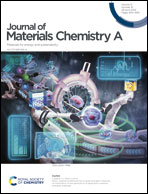Boosting oxygen-resistant CO2 electroreduction reaction in acidic media over conjugated frameworks†
Abstract
The use of flue gas (containing 3–4% O2) as the direct feed gas for the CO2 electroreduction reaction (CO2RR) is a promising protocol to reduce CO2 purification costs. However, the competitive oxygen reduction reaction (ORR) and cathodic carbonate salt precipitation severely hinder its practical application. Here, we realize efficient CO2RR towards CO under CO2 containing 5% O2 gas feed in conditions of acidic media. A conjugated cobalt polyphthalocyanine framework (CoPPc) shows outstanding performance in aqueous acidic electrolyte (H2SO4 + 0.4 M Cs2SO4, pH = 3.0) with a faradaic efficiency toward CO (FECO) exceeding 95% over a wide potential range from −1.0 to −1.9 V vs. a reversible hydrogen electrode (RHE), and a maximum CO partial current density (jCO) up to −294 mA cm−2 when using pure CO2 gas. After coating with polyaniline (PANI), CoPPc@PANI shows a high FECO of up to 87.4% and a maximum industrial level current density of −270 mA cm−2 at −2.1 V vs. RHE under 95% CO2 + 5% O2 feed gas in acidic media. The results of the oxygen reduction reaction, CO2 adsorption capacity and the isosteric heat of adsorption (Qst) demonstrate that CoPPc@PANI can adsorb and enrich CO2 in comparison with oxygen, resulting in superior CO2 reduction performance in the presence of O2. This work will shed new light on the development of efficient electrocatalysts for CO2RR using flue gas, which can reduce separation costs and avoid the formation of cathodic carbonate salt precipitates.

- This article is part of the themed collection: 2024 Journal of Materials Chemistry A HOT Papers


 Please wait while we load your content...
Please wait while we load your content...